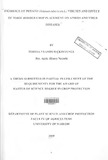| dc.description.abstract | A survey was carried out using structured questionnaire in six districts and twelve markets to
establish seed potato production practices and incidence of potato viruses in farmers' produced
seeds. Samples of potato tubers were also collected for serological analysis of viruses using
Double Antibody Sandwich Enzyme-Linked Immunosorbent Assay method. A field experiment
was also conducted at National Potato Research Centre, Tigoni over two seasons to determine
the effect of maize border crop placement on aphids and aphid-transmitted viruses in Irish
potatoes. The maize border was placed at 0.5, 1.0, 1.5, 2.0, 2.5 and 3.0 metres. Data collected
from the field experiment was on population of aphids, virus disease incidences, virus titre, plant
height and tuber yield. Data obtained was analyzed using Statistical Package for Social Science
and GenSat software.
The survey revealed that all the farmers interviewed had used their own seed potato and only
1.6% of the farmers sourced seed from research stations. Tigoni was the most preferred variety
by most farmers (25.8%), while Nyayo was the most preferred variety by the traders. Farmers
considered high yields in the choice of a new variety and chemical control was the most
preferred method for the control of pests and diseases. Fifty percent and 49.2% of the farmers
had seen virus disease symptoms and aphids in potatoes respectively. Majority of the farmers
(46.7%) obtained less than 2 tons/acre. The incidence of virus and virus titres in tubers differed
among districts and retail markets and the viruses detected were potato leaf roll virus, potato
virus A, potato virus M, potato virus S, potato virus X and potato virus Y. Potato virus S was the
most prevalent viruses in the farmers' produced seed potato. There were significant differences
among the districts in the incidence of all the viruses, except potato virus A and potato virus S.
There were significant differences among the districts in the titre of all the viruses except Potato
leaf roll virus and Potato virus Y.
From the field experiment the aphid species identified were, Myzus persicae, Macrosiphum
euphorbiae, Aphis gossypii, Aphis fabae and Rophalosiphum maidis. The most abundant aphid
species on the leaves during long rain season was M euphorbiae while, A. gossypii was the most
abundant in short rain season. R. maidis was the most abundant species in yellow waterpan traps
during both seasons. Placement of maize border up to 1.5m and 1.0m had a significant reduction
in virus disease incidences by upto 50% and 60% during short rain and long rain seasons
respectively. Lowest virus titre was recorded in tubers from plots with maize border placed at
0.5 m and 1.0 m from potato while the lowest tuber yield was recorded in potato plots with maize
border placed at 0.5 m.
Maize border crop can be used by farmers to reduce transmission of aphids and aphidtransmitted
viruses in Irish potatoes. The effective distance for the placement of maize border is
1.0 m. However, there is need to carry out research to determine the number of seasons a farmer
can plant seed potato harvested from plots with maize border crops before yields are reduced to
uneconomical level. | en |

